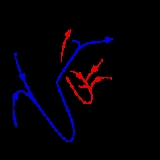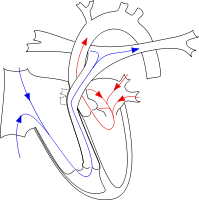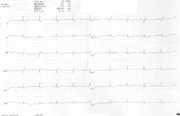
Ebstein's anomaly
Encyclopedia
Ebstein anomaly is a congenital heart defect
in which the opening of the tricuspid valve
is displaced towards the apex of the right ventricle
of the heart
.
during the first trimester of pregnancy (though some have questioned this) and in those with Wolff-Parkinson-White syndrome
.
 While Ebstein anomaly is defined as the congenital displacement of the tricuspid valve towards the apex of the right ventricle, it is often associated with other abnormalities.
While Ebstein anomaly is defined as the congenital displacement of the tricuspid valve towards the apex of the right ventricle, it is often associated with other abnormalities.
About 50% of individuals with Ebstein anomaly have an associated shunt between the right and left atria, either an atrial septal defect
or a patent foramen ovale.
, secondary to the atrialized right ventricular tissue.
 Other abnormalities that can be seen on the ECG include (1) signs of right atrial enlargement or tall and broad 'Himalayan' P waves, (2) first degree atrioventricular block manifesting as a prolonged PR-interval, (3) low amplitude QRS complexes in the right precordial leads, (4) atypical right bundle branch block
Other abnormalities that can be seen on the ECG include (1) signs of right atrial enlargement or tall and broad 'Himalayan' P waves, (2) first degree atrioventricular block manifesting as a prolonged PR-interval, (3) low amplitude QRS complexes in the right precordial leads, (4) atypical right bundle branch block
, (5) T wave inversion in V1-V4 and Q waves in V1-V4 and II, III and aVF.
. Since AV-blockade may promote conduction over the accessory pathway, drugs like beta blockers, calcium channel blocker
s and digoxin
are contraindicated.
If there is atrial fibrillation
with pre-excitation, treatment options include procainamide
, flecainide
, propafenone
, dofetilide
and ibutilide
since these medications slow conduction in the accessory pathway causing the tachycardia and should be administered before considering electrical cardioversion
. Intravenous amiodarone
may also convert atrial fibrillation and/or slow the ventricular response.
Congenital heart defect
A congenital heart defect is a defect in the structure of the heart and great vessels which is present at birth. Many types of heart defects exist, most of which either obstruct blood flow in the heart or vessels near it, or cause blood to flow through the heart in an abnormal pattern. Other...
in which the opening of the tricuspid valve
Tricuspid valve
The tricuspid valve, or right atrioventricular valve, is on the right dorsal side of the mammalian heart, between the right atrium and the right ventricle. The normal tricuspid valve usually has three leaflets and three papillary muscles. They are connected to the papillary muscles by the chordae...
is displaced towards the apex of the right ventricle
Right ventricle
The right ventricle is one of four chambers in the human heart. It receives deoxygenated blood from the right atrium via the tricuspid valve, and pumps it into the pulmonary artery via the pulmonary valve and pulmonary trunk....
of the heart
Heart
The heart is a myogenic muscular organ found in all animals with a circulatory system , that is responsible for pumping blood throughout the blood vessels by repeated, rhythmic contractions...
.
Presentation
The annulus of the valve is still in the normal position. The valve leaflets, however, are to a varying degree, attached to the walls and septum of the right ventricle. There is subsequent 'atrialization' of a portion of the morphologic right ventricle (which is then contiguous with the right atrium). This causes the right atrium to be large and the anatomic right ventricle to be small in size.Risk factors
There is an enlargement of the aorta which may cause an increased risk of abnormality in infants of women taking lithiumLithium pharmacology
Lithium pharmacology refers to use of the lithium ion, Li+, as a drug. A number of chemical salts of lithium are used medically as a mood stabilizing drug, primarily in the treatment of bipolar disorder, where they have a role in the treatment of depression and particularly of mania, both acutely...
during the first trimester of pregnancy (though some have questioned this) and in those with Wolff-Parkinson-White syndrome
Wolff-Parkinson-White syndrome
Wolff–Parkinson–White syndrome is a disorder of the heart in which the ventricles of the heart contract prematurely due to an accessory pathway known as the bundle of Kent. This accessory pathway is an abnormal electrical communication from the atria to the ventricles...
.
Related abnormalities

Anatomic abnormalities
Typically, there are anatomic abnormalities of the tricuspid valve, with enlargement of the anterior leaflet of the valve.About 50% of individuals with Ebstein anomaly have an associated shunt between the right and left atria, either an atrial septal defect
Atrial septal defect
Atrial septal defect is a form of congenital heart defect that enables blood flow between the left and right atria via the interatrial septum. The interatrial septum is the tissue that divides the right and left atria...
or a patent foramen ovale.
Electrophysiologic abnormalities
About 50% of individuals with Ebstein anomaly have evidence of Wolff-Parkinson-White syndromeWolff-Parkinson-White syndrome
Wolff–Parkinson–White syndrome is a disorder of the heart in which the ventricles of the heart contract prematurely due to an accessory pathway known as the bundle of Kent. This accessory pathway is an abnormal electrical communication from the atria to the ventricles...
, secondary to the atrialized right ventricular tissue.

Right bundle branch block
A right bundle branch block is a defect in the heart's electrical conduction system.During a right bundle branch block, the right ventricle is not directly activated by impulses travelling through the right bundle branch. The left ventricle however, is still normally activated by the left bundle...
, (5) T wave inversion in V1-V4 and Q waves in V1-V4 and II, III and aVF.
Pharmacological
Ebstein's cardiophysiology typically presents as an (antidromic) AV reentrant tachycardia with associated pre-excitation. In this setting, the preferred pharmacological treatment agent is procainamideProcainamide
Procainamide INN is a pharmaceutical antiarrhythmic agent used for the medical treatment of cardiac arrhythmias, classified by the Vaughan Williams classification system as class Ia.-History:...
. Since AV-blockade may promote conduction over the accessory pathway, drugs like beta blockers, calcium channel blocker
Calcium channel blocker
A calcium channel blocker is a chemical that disrupts the movement of calcium through calcium channels.CCB drugs devised to target neurons are used as antiepileptics. However, the most widespread clinical usage of calcium channel blockers is to decrease blood pressure in patients with...
s and digoxin
Digoxin
Digoxin INN , also known as digitalis, is a purified cardiac glycoside and extracted from the foxglove plant, Digitalis lanata. Its corresponding aglycone is digoxigenin, and its acetyl derivative is acetyldigoxin...
are contraindicated.
If there is atrial fibrillation
Atrial fibrillation
Atrial fibrillation is the most common cardiac arrhythmia . It is a common cause of irregular heart beat, identified clinically by taking a pulse. Chaotic electrical activity in the two upper chambers of the heart result in the muscle fibrillating , instead of achieving coordinated contraction...
with pre-excitation, treatment options include procainamide
Procainamide
Procainamide INN is a pharmaceutical antiarrhythmic agent used for the medical treatment of cardiac arrhythmias, classified by the Vaughan Williams classification system as class Ia.-History:...
, flecainide
Flecainide
Flecainide acetate is a class Ic antiarrhythmic agent used to prevent and treat tachyarrhythmias . It is used to treat a variety of cardiac arrhythmias including paroxysmal atrial fibrillation , paroxysmal supraventricular tachycardia Flecainide acetate is a class Ic antiarrhythmic agent used to...
, propafenone
Propafenone
Propafenone is a class Ic anti-arrhythmic medication, which treats illnesses associated with rapid heart beats such as atrial and ventricular arrhythmias.-Mechanism of action:...
, dofetilide
Dofetilide
Dofetilide is a class III antiarrhythmic agent.It is marketed under the trade name Tikosyn by Pfizer, and is available in the United States in capsules containing 125, 250, and 500 µg of dofetilide....
and ibutilide
Ibutilide
Ibutilide is a Class III antiarrhythmic agent that is indicated for acute cardioconversion of atrial fibrillation and atrial flutter of a recent onset to sinus rhythm. It exerts its antiarrhythmic effect by induction of slow inward sodium current, which prolongs action potential and refractory...
since these medications slow conduction in the accessory pathway causing the tachycardia and should be administered before considering electrical cardioversion
Cardioversion
Cardioversion is a medical procedure by which an abnormally fast heart rate or cardiac arrhythmia is converted to a normal rhythm, using electricity or drugs. Synchronized electrical cardioversion uses a therapeutic dose of electric current to the heart, at a specific moment in the cardiac cycle...
. Intravenous amiodarone
Amiodarone
Amiodarone is an antiarrhythmic agent used for various types of tachyarrhythmias , both ventricular and supraventricular arrhythmias. Discovered in 1961, it was not approved for use in the United States until 1985...
may also convert atrial fibrillation and/or slow the ventricular response.
External links
- Ebstein's Malformation information from Seattle Children's Hospital Heart Center
- Ebstein's Anomaly at Cardiopedia
- Overview and diagram at Mayo ClinicMayo ClinicMayo Clinic is a not-for-profit medical practice and medical research group specializing in treating difficult patients . Patients are referred to Mayo Clinic from across the U.S. and the world, and it is known for innovative and effective treatments. Mayo Clinic is known for being at the top of...
- Information and support for those affected by Ebstein's anomaly
- Resource for Adults living with Ebstein's Anomaly

